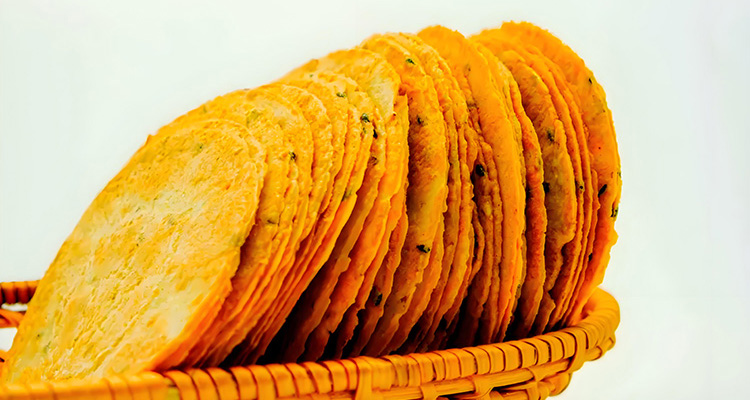Xiyang Pressed Pancake: Shanxi’s Crispy Millet Pancake Snack
Imagine standing in the warm sunlight of Jinzhong, Shanxi, holding a paper-thin, golden pancake. You take a bite—crunch—and a rich toasted grain aroma fills your mouth. This is Xiyang pressed pancake (昔阳压饼, yabing): a humble, centuries-old snack born from coarse grains and refined craftsmanship. For food travelers seeking authentic Chinese flavors, Xiyang pressed pancake is a must-try. This guide explores its history, meaning, flavor, technique, and how to enjoy it like a local.
1. Origin in the Ming Dynasty: A Pancake That Carries History
Xiyang pressed pancake dates back to the Ming Dynasty and the famous “Big Locust Tree Migration.” As people moved from central China to Shanxi, they needed food that was light, durable, and easy to carry. Locals created a thin, low-moisture pancake from milled coarse grains and baked it on a double-sided iron press.
This simple invention fed travelers and became a regional staple. Today, it remains a delicious reminder of that migration and the perseverance of Shanxi’s people.
2. Cultural Meaning: Coarse Grains, Fine Craftsmanship
This snack reflects a timeless Chinese philosophy—turning simplicity into perfection through skill.
On the loess plateau, millet, maize, and buckwheat were once considered plain foods. But with fine milling and expert baking, they transformed into something delicate and aromatic.
In Xiyang, these pancakes are not only everyday fare but also offered at festivals and to guests—symbolizing thrift, ingenuity, and warm hospitality.
3. Ingredients and Flavor: Simple Components, Surprising Taste
Main ingredients: high-quality wheat flour, locally milled millet flour, salt, toasted sesame, a pinch of ground Sichuan pepper, cooking oil, and water.
Flavor and texture: The first bite delivers ultra-crisp lightness, followed by roasted grain and nutty aromas. A hint of Sichuan pepper adds gentle heat, balancing the pancake’s oiliness.
It’s a healthy, non-fried snack that perfectly fits modern preferences for natural and light flavors.

4. Craftsmanship: The Unique “Pressed Ao” Technique
The secret behind the pancake lies in the pressed ao (压饼鏊, ào)—a heavy double-sided cast-iron press heated on both sides.
Here’s how it’s made:
- Prepare the batter: Mix wheat and millet flours, salt, pepper, and water into a smooth, pourable consistency.
- Heat the press: Brush both sides with a thin layer of oil.
- Pour and press: Spoon the batter onto the lower plate, close the heavy top, and press down.
- Bake: In just one to two minutes, the pancake turns golden, crisp, and wafer-thin.
This process requires speed, precision, and years of experience—a true craft of local masters.
5. How to Enjoy It: Local Ways to Eat Xiyang Pressed Pancake
- Eat it plain: Enjoy the pure crispness as a tea-time or travel snack.
- Soak it in porridge: Break it into small pieces and mix with hot millet porridge—the texture becomes soft and chewy, a comforting local breakfast.
- Pair it with tea: Try it with Longjing green tea or a bold black tea for a perfect sweet-salty balance.
6. Traveler Tips: Experience It Like a Local
- Where to try: Visit local snack streets, century-old bakeries, or farmers’ markets to watch it made fresh.
- What to buy: Packaged pancakes make light, long-lasting souvenirs.
- Best season: Freshly baked pancakes after the autumn millet harvest have the richest aroma.
- Packing tip: They’re delicate—use a rigid box to avoid breakage.

7. Home Attempt: Recreate the Flavor at Home
You can make a simplified version in your kitchen:
- Mix wheat and millet flours, salt, ground Sichuan pepper, and toasted sesame.
- Add water gradually until the batter is slightly thicker than yogurt; let it rest for 15 minutes.
- Heat a nonstick pan on low, brush with oil.
- Pour a small ladle of batter, spread it thin with the back of a spoon.
- Cook both sides until crisp and golden.
You won’t have the traditional iron press, but you’ll still get that light, crispy texture and toasty aroma.
Conclusion: A Crunch That Echoes History
Xiyang pressed pancake is more than a snack—it’s a story you can taste.
From its Ming dynasty origins to its modern-day revival, every bite tells of migration, craftsmanship, and resilience. So when you visit Shanxi, don’t just admire its temples or mountains—follow the aroma, listen for that satisfying crunch, and let this golden pancake become an unforgettable highlight of your food journey.


